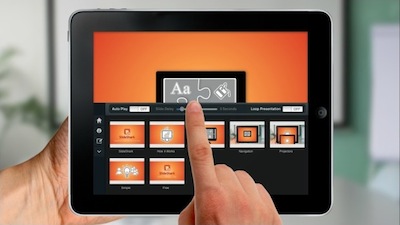Want to make exciting presentations? Turn off the projector!
 Given the level of development of modern broadcasting technologies and mobile devices, meeting organizers and “presenters” in all areas of business should forever forget about the projector.
Given the level of development of modern broadcasting technologies and mobile devices, meeting organizers and “presenters” in all areas of business should forever forget about the projector.And that's why. Since the mid-1980s, the availability of computers in the conference room has been fundamentally viewed as a distraction. Over the past 15 years, it has become the norm to come to meetings with laptops, and it was considered a good place to charge a computer from. In addition, the laptop screen "specially" was placed in such a way that would create the effect of visibility of work on important tasks.
The table covered with laptops in the conference room is a “digital wall” separating the participants of the presentation not only from each other and from the speaker himself. Perhaps unintentionally, but the laptop screen is for people a kind of protection, not much different at the psychological level, for example, from folding hands. Naturally, this is far from an ideal environment for establishing contact with the participants of the meeting and involving them in the discussion.
Since 2005, mobile phones are trying to simultaneously decrease in size and increase their functionality. In 2007, the iPhone appeared and unexpectedly penetrated deep into the corporate segment, especially among managers and managers. So it is quite natural that the number of laptops on the table began to decrease. However, the visitors of the meetings now had a completely new “reason” to distract. With the iPhone, you could go anywhere, it was perfect for corporate needs and worked for ten hours without recharging. As soon as it became clear that smartphones could compete with laptops in their computing capabilities, mobile devices were no longer tracked at the entrance to the conference room as a firearm. High-resolution cameras, a digital voice recorder, and many note-taking applications marked a new era of annoying presentations.
')
Record the contents of the meeting was made possible directly to the mobile gadget. Digital snapshots of demo boards and text messages to presentations were early examples of what has now become the billionth segment in the field of mobile applications that transform mobile devices into real productivity-enhancing meeting tools and allow you to plan, organize and effectively conduct business meetings of all types and levels.

Until recently, only “legitimate” computing tools that worked with the PowerPoint slide show program were used in conference rooms, usually using a projector with a screen. And, despite the sea of opportunities provided by mobile technologies in the segment of meetings and presentations, the presence of other devices is still seen as a distracting innovation.
Indeed, the corporate policy of meetings and the unwritten rules of ethics (for example, switching phones to silent mode) led to a total ban on everything that has a screen. In some companies, you have more chances to play Angry Birds on your iPad when taking off or landing an aircraft than jotting down a few notes during a market strategy discussion session with the CEO. After all, if possible, people can not resist the temptation to escape from the "boring" slide show presentation on the sea of entertainment provided by modern devices.
But times have changed. Our employers expect us to always be in touch, and our colleagues and subordinates need both constant attention and timely guidance. Modern mobile devices are quite capable of providing us with all this managerial "magic."
And if you want to achieve the full attention of the audience, you must once and for all abandon the projector. What for? To place the contents of the presentation in the hands of your listeners. How? Eliminate the "multitasking" of the audience, turning the mobile devices that distract them into a visual channel of communication with the audience!
John Windsor, founder and CEO of Creating Thunder, maker of Peak Meetings , an iPad application designed to help conduct productive meetings, notes:
“... the impulse (in the culture of a business meeting) is to transfer the content of the meeting directly into the hands of the audience. And this is a great idea that will help make the data more personal and convey them to absolutely everyone in the group. ”
If participants are given direct access to meeting materials from the very first seconds, this will involve them immediately and permanently. This will allow them to better organize their thoughts and formulate a dialogue with the presenter with greater confidence.
Visually, people better perceive those things that are close to them, and especially if they hold them in their hands. This approach will allow you to fully capture the attention of the audience. Contrary to accepted presentation practices, companies should encourage the use of mobile devices in meetings, and not be afraid of them. Therefore, today we invite you to familiarize yourself with the application, providing a multi-faceted and creative approach to any presentation. Meet SlideShark .
SlideShark
 The recently announced SlideShark Broadcasting application, which has impeccable design, seamless integration with PowerPoint and the ability to transfer content directly to the listener, would bring the seemingly ordinary business of presentations to new heights.
The recently announced SlideShark Broadcasting application, which has impeccable design, seamless integration with PowerPoint and the ability to transfer content directly to the listener, would bring the seemingly ordinary business of presentations to new heights.SlideShark for iPad is ideal for face-to-face presentations as well as face-to-face talks. SlideShark for iPhone, in turn, allows you to conduct PowerPoint-presentations with almost one hand under any lighting conditions and in any conference rooms.
By combining only three easy-to-use technologies: iOS devices, Airplay, and the SlideShark app, businesses can make presentations and meetings that anticipate the highest expectations of participants. SlideShark for iPad, of course, is the most effective and elegant presentation control panel, for speakers and listeners alike.
The SlideShark Broadcasting feature opens up gateways for innovative use of the iPad and iPhone as presentation solutions. With the help of broadcasting, coordinators and presenters can engage listeners in live participation and discussion of the subject. Participants who are at least on the other side of the table, at least on the other side of the world can follow the presentation from any computer, tablet or smartphone connected to the Internet, view enlarged slides, expanded animations, as well as drawings and annotations created by the presenter.
Can you imagine how many companies conduct training sessions indoors or in classrooms equipped with special equipment just because it is impractical (from a technical point of view) to hold such events in more suitable places that correspond to the context of training? Now present the presentation on the iPad for a group of quality control engineers as they move around the production site. This is not a new idea, but this is something that has recently become possible; innovative alchemy of learning + mobility + location corresponding to the presentation material.
If presentations can move away from projectors and conference rooms, the very definition of a presentation will change into learning and collaboration, anytime, anywhere!
Brainshark's marketing director, Andy Zimmerman, shares his own experience with us: “As a presenter with experience, I can say that it’s difficult to capture the attention of an audience that has dropped eyes. But our latest technological advancement provides an opportunity to capitalize on the omnipresence of mobile devices. With the new ability to stream content through SlideShark, you will not object to those who have lowered their heads and are looking down to view your presentation more closely and watch in real time from your mobile devices as you continue to manage slides. This can completely change the dynamics of presentations and, most importantly, increase your influence on the audience! ”
SlideShark allows you to turn off the projector and expand collaboration with the audience during the presentation. And by the way, at the end of the meeting, SlideShark provides the organizers with detailed reports on the audience: its activity, number of views and presence of participants.
Source: https://habr.com/ru/post/178449/
All Articles